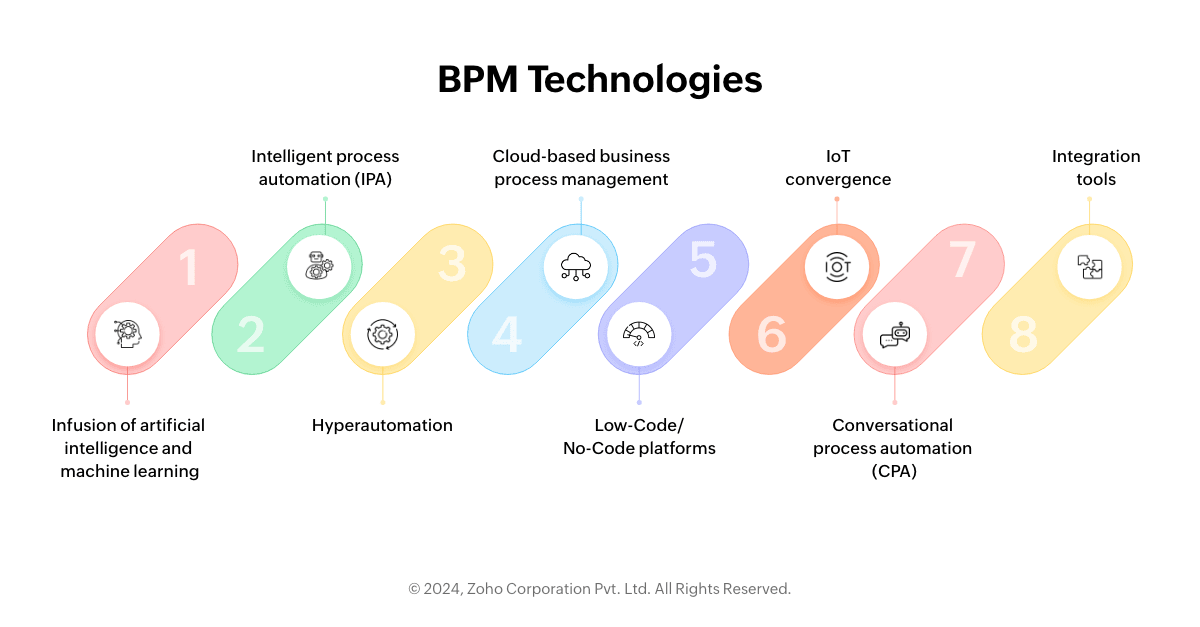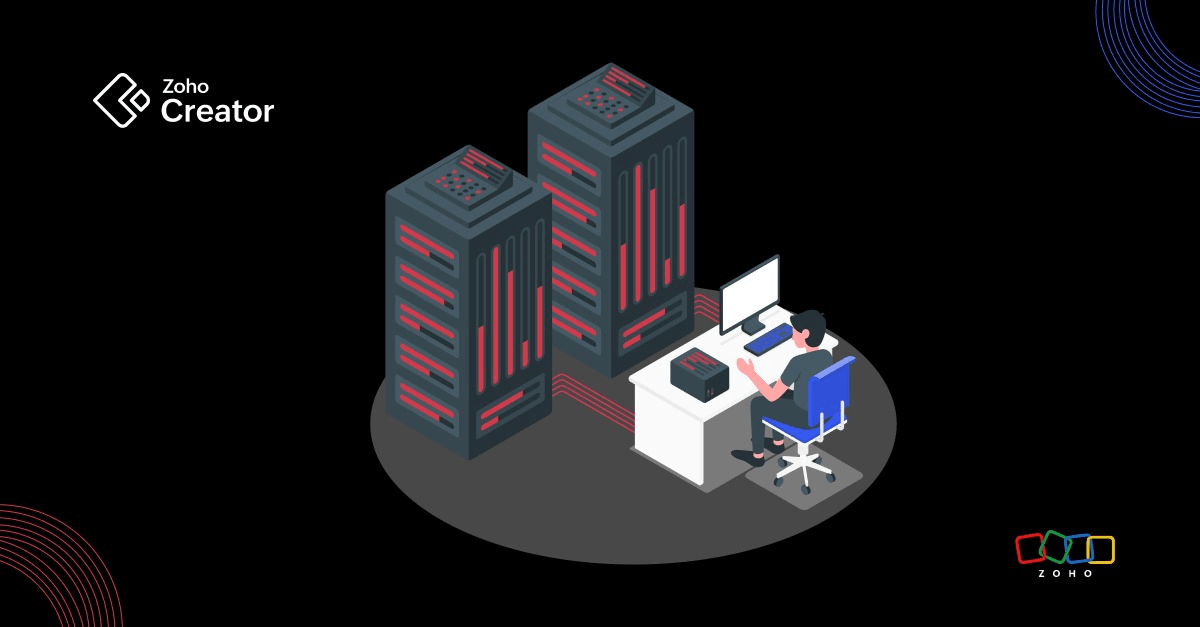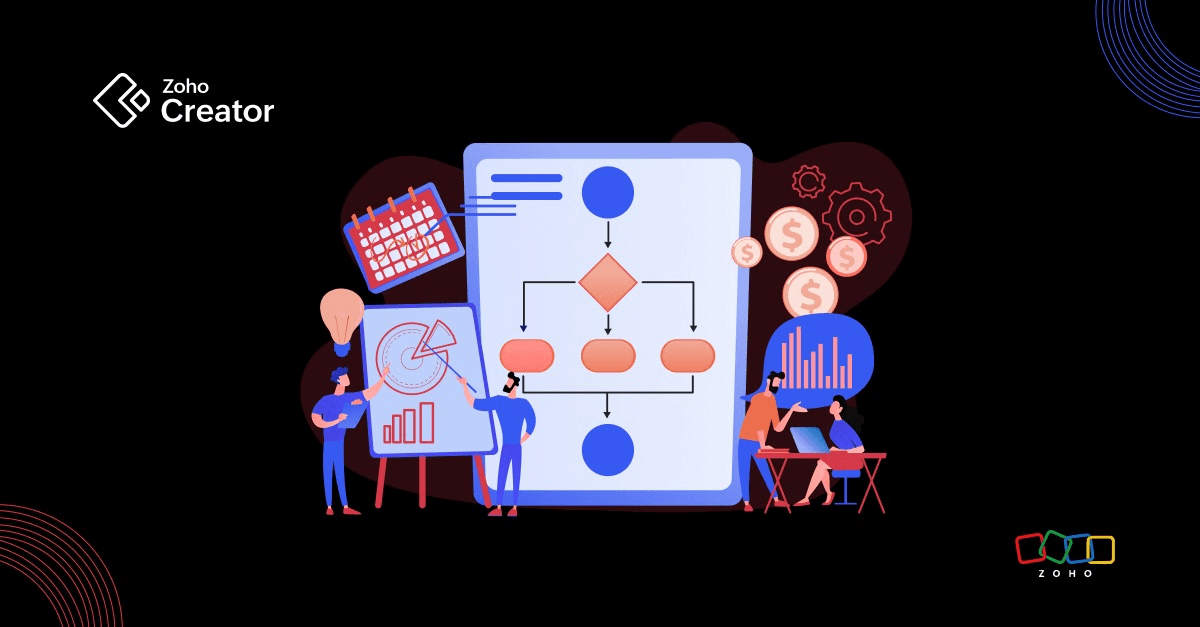- HOME
- Know Your Tech
- 15 BPM trends and technologies that are set to shape the landscape
15 BPM trends and technologies that are set to shape the landscape
- Last Updated : August 16, 2024
- 530 Views
- 6 Min Read
Business process management (BPM) and beats per minute (BPM) both emphasize rhythm, synchronization, and efficiency. Just like music can sound sluggish at a slow BPM or rushed at a fast one, business processes can be inefficient if they are too slow or lead to errors if they are too fast.
BPM software helps businesses find the "sweet spot" for their processes, leading to a smooth and efficient flow, much like a well-conducted music piece.
To improve process efficiency and streamline operations better, BPM solutions themselves are undergoing an evolution with advanced technologies and intelligent systems becoming an integral part. These advancements enable businesses to reap key benefits like improving business processes to hit business goals. Let's look at the BPM trends and technologies that are going to shape BPM solutions over the next couple of years.
BPM technologies

#1 Infusion of artificial intelligence (AI) and machine learning(ML)
AI and ML is being woven into the fabric of BPM many ways. Here's where the infusion of this power duo will transform BPM:
Automated process discovery
Manual process mapping will become a relic of the past. AI-powered tools will automatically discover and analyze existing processes, extracting valuable insights into process performance.
Efficient process mining
Not only can AI do the grunt work of analyzing huge amounts of data from existing systems to map existing processes, but it can also then identify patterns and bottlenecks within these processes and even highlight repetitive tasks in a business process.
Continuous process optimization
Process management is never a one-time thing; it requires continuous improvement. AI can leverage predictive analytics to forecast potential issues and suggest alternative process flows.
Advanced process simulation
Businesses will be able to leverage AI to simulate the impact of potential process changes before implementing them in real-world scenarios. This "what-if" analysis will allow for more confident decision-making and a reduction in the risk of disrupting critical workflows.
Real-time process monitoring and exception handling
Imagine a system that can automatically detect deviations from the standard process and trigger corrective actions to ensure smooth execution. That's what AI can enable with real-time process monitoring, allowing for proactive identification and expectation resolution.
#2 Intelligent process automation (IPA)
IPA truly contributes to digital transformation in a business as it builds on top of BPM by using AI and ML to automate tasks within a business process. While BPM focuses on overall process improvement, IPA focuses on process automation, like automating tasks within those processes.
For example, imagine building a house. In the construction of a house, BPM is like designing the blueprint—figuring out the layout, rooms, and functionalities. IPA is like using power tools and prefabricated components to construct the house faster and more efficiently.
#3 Hyperautomation
Hyperautomation is the use of multiple automation tools and technologies, such as robotic process automation (RPA), AI, and ML to automate a business process as much as possible, from simple tasks to complex workflows and business operations.
#4 Cloud-based business process management
Cloud-based BPM is essentially BPM software delivered through the internet instead of being installed on a company's servers. This type of software is becoming increasingly popular as it enables businesses to improve operational efficiency without having to invest and maintain any additional IT infrastructure. The system can easily scale to handle increased data volumes and expanding business operations.
Cloud BPM also fosters seamless collaboration on processes across teams and locations. Features like real-time process visibility, shared workspaces, and mobile accessibility can streamline communication and process execution.
#5 Low-code/No-code platforms
Low-code development platforms are making it easier for businesses to develop and deploy BPM applications without the need for a lot of programming expertise. These platforms are more user-friendly, making BPM more accessible to a wider range of user personas.
Citizen development
The rise of low-code and no-code platforms empowers non-technical users to become business process experts and build innovative solutions using intuitive, visual tools to optimize their own business processes and address their specific needs without relying heavily on IT departments.
Faster deployment
Low-code/no-code platforms significantly reduce the time-to-market for new applications and process changes. Organizations can quickly adapt to market changes, meet business objectives, and drive digital transformation.
#6 IoT convergence
Integrating IoT devices with BPM allows for the piping of real-time data from connected devices enabling smarter, more responsive operations.
A key benefit of BPM and IoT working together is predictive maintenance. Collected data can be used to predict and prevent equipment failures and optimize maintenance schedules. Predictive maintenance can ensure that operations run smoothly, reducing downtime.
#7 Conversational process automation (CPA)
Conversational process automation (CPA) changes how people interact with these vital business tools by bridging the gap between humans and BPM systems through natural language interaction. By leveraging the power of natural language, CPA bridges the gap between humans and machines, making processes more intuitive.
Here's how CPA streamlines the experience.
Natural language processing (NLP): Using voice commands or chatbots to initiate tasks, request approvals, or retrieve process information can make BPM systems more user-friendly and accessible to a wider range of users.
Conversational guidance: Chatbots powered by AI will act as virtual assistants, guiding users by providing step-by-step instructions.
#8 Integration tools
Tools like APIs and middleware solutions act as digital bridges, facilitating smooth data exchanges.
This ensures data consistency, meaning information remains accurate and up to date across all connected systems. Additionally, process continuity is guaranteed, as data flows freely without disruption, keeping workflows between systems running smoothly.
BPM trends

#1 Compliance and governance
These two fundamental pillars are not solely for a BPM system but the business processes they help optimize. They create a framework that minimizes risk and ensures long-term success.
Automated compliance checks and audits within BPM platforms ensure processes adhere to industry regulations and standards. This capability is crucial for maintaining regulatory compliance and avoiding potential legal issues.
Implementing robust security measures within BPM systems protects sensitive information, ensuring data integrity and confidentiality.
#2 Green initiatives
Go green with BPM!
Sustainable business practices involve ensuring business processes are environmentally friendly. Incorporating environmental, social, and governance (ESG) criteria into business processes is becoming increasingly important. Green BPM focuses on optimizing processes to reduce their environmental impact and support corporate sustainability goals.
#3 BPM for front-end processes
Traditionally, BPM has focused on making back-end processes better, such as those related to accounting and inventory management. However, there is a growing trend towards using a BPM tool to improve front-end processes that interact directly with customers and suppliers. This includes processes such as order fulfillment, customer service, and claims processing. This focus can improve customer satisfaction.
#4 Adaptive case management (ACM)
Change in a business is constant and necessary. To remain competitive, organizations are shifting their focus towards real-time monitoring and actual implementation. ACM systems can dynamically adjust the process flow based on real-time data and events. This makes them ideal for processes like sales distribution, claims processing, and more.
#5 Agile BPM
Like ACM, Agile BPM—also known as Adaptive BPM—is a business process management approach that prioritizes flexibility and responsiveness, incorporating the principles of agile project management into BPM processes.
The agile method involves iterative development, collaboration, and quick feedback loops. Processes are divided into smaller, manageable increments to enable testing and validating new ideas more rapidly.
With Agile BPM, businesses can swiftly respond to changing market dynamics and customer demands.
#6 Human-centric BPM
BPM often prioritizes tasks over people. Human-centric BPM flips the script, designing processes with the user experience in mind. It aims for user-friendly, efficient, and engaging experiences for both employees and customers.
This approach goes beyond automation. It prioritizes understanding user needs through surveys and feedback. Imagine a customer service process designed with a user-friendly complaint portal and clear communication channels.
At the heart of human-centric BPM is usability. Processes are designed with intuitive interfaces and undergo usability testing for refinement.
By prioritizing the human experience, human-centric BPM leads to happier employees, satisfied customers, and overall business growth.
#7 Mobile BPM
The burgeoning capabilities of smartphones and tablets have transformed them from personal devices to powerful business tools. This widespread adoption of mobile technology has significantly impacted BPM, leading to the integration of advanced and customizable mobile task support.
Mobile BPM solutions address this shift by empowering employees with on-the-go access and management of critical business processes. These solutions come in two primary forms: mobile applications and web-based interfaces. This flexibility allows users to seamlessly view, initiate, and complete tasks regardless of location, fostering continuous connectivity and productivity.
No longer chained to their desks, employees can leverage mobile BPM to stay ahead of deadlines and contribute meaningfully, even while traveling or working remotely. Mobile BPM also significantly enhances customer service by granting employees access to crucial customer data while on the move.
Just like how a great track has a steady beat, these advancements will rid us of process breakdowns or workflow hiccups and pave the way to rhythmic business process management.
 Judith Figredo
Judith FigredoA marketer focused on conveying technology as simply, interestingly, and concisely as I can.



